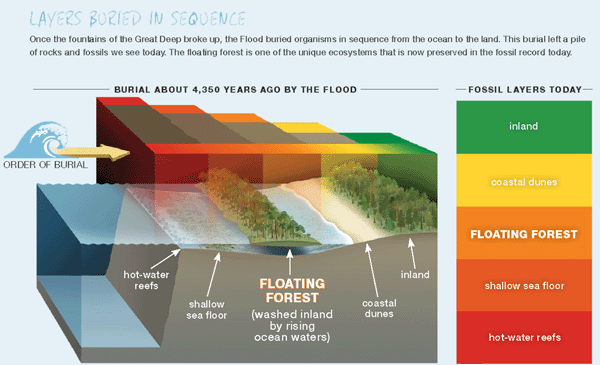Sinking a Floating Forest
Part 2: World Underwater
Have you ever wondered about the kinds of exotic environments that God created from scratch during Creation Week? What an astonishing array of fully functional communities He must have made!
Paleontologist Kurt Wise shares one example: A vast forest once floated atop the ocean, filled with combinations of strange plants and animals unlike anything we see today.
This is a personal account of how the bizarre idea of a continent-sized floating forest came to be. The story began as I mulled over the claim that the fossil record order is explained by evolution. As a paleontologist and a creationist, I wanted to examine the claim.
Is There an Order?
The first step was to determine if the claim was based on facts (or data, as we say in the business). Does evolutionary theory expect an order? Does the fossil record have an order? How do they compare?
Does evolution expect an order?1 If all organisms descended from a single common ancestor, they should have appeared in order. To identify that sequence, evolutionists study similarities among organisms. Evolution is then assumed to follow the simplest path that connects all the similarities among all organisms—the evolutionary tree with the fewest branches and the fewest and simplest changes.
If evolution were true, the order of organisms in the fossil record should match the order of evolution. When I compared the two sequences for all organisms, the order of evolution rarely fit the fossil order. The best example, by far, was among the plants. If evolution explained any fossil order, it was that of the plants. An evolutionist might stop right there, satisfied that no further evidence for evolution was needed.2
What’s the Real Cause?
Click here to view a chart entitled “Exotic Communities Buried by the Flood” (PDF format, approx. 1MB)
But evolution cannot be the cause. The Bible indicates that different plant groups were specially created, not evolved. Furthermore, the six days of creation are clearly six ordinary days and therefore don’t allow enough time for evolution. The creationist must seek another cause. He must do more science, “studying the facts of God’s Word and world” to develop alternative theories.
As I considered the evolutionary story for plants, I remembered what I was taught . . . that it was the history of plants rising out of the sea. Evolutionists see plants as evolutionary solutions to the challenges of living on land. Unlike algae, which live in water and don’t need such things, plants (tracheophytes) contain tracheids to transport water, and a waxy cuticle to conserve water. Competing for sunlight, plants need lignin and cellulose for enough strength to rise above the surface of the ground. They also need branches and leaves to do more photosynthesis.
From an evolutionary perspective, the fossil record should show the time sequence of plants as they acquired increasingly sophisticated adaptations for living free of water. From a biblical perspective, “adaptations” would be God’s original designs for plants living in different environments, and the “time” sequence might actually be an “ecological” sequence of plants living at the same time in what’s known as a geographic gradient. God could have planted the plants in an ecological sequence, with increasingly sophisticated designs for living more and more free of water.
At the same time something else was nagging at me. Often, fossil plants were associated with marine sediments and animals. Where, I wondered to myself, have I seen an ecosystem like this—a sequence of plants of increasing size and strength—all associated with water? I remembered such an ecosystem . . . a quaking bog.
As a preteen, I visited a quaking bog in Michigan as part of a small group of youth led by a biology graduate student, Bill Maxey. At one point in the forest Bill stopped and told the group to join hands and jump. After a few failed attempts, we jumped with the right timing and realized that the ground was moving. Each time we landed, the ground would drop down and a circular wave would move along the forest floor in all directions away from us. As these waves got to the base of trees, the trees would swing first toward and then away from us.
I suddenly realized the whole forest was floating atop a lake. As we moved toward the center of the lake, the mat under us became thinner and easier to make move up and down. Before we got to open water, the mat became too thin to support our weight, even when we were crawling on all fours. As the mat thinned toward the water’s edge, the plants grew smaller and weaker—from trees to tall bushes to short bushes to reeds to frail water plants.
The Theory Formulated
If such a quaking bog were to explain the huge number of fossil plants, the bog would have to be enormous—the size of a continent. Since most of it would be forest, with smaller plants only around the edge, it would really be a floating forest. It turns out that floating vegetation mats are surprisingly common in the present day, and the mats can be made of different plants in very different environments (acidic quaking bogs in cold temperate North America, papyrus in warm temperate Africa, tropical forest in Amazonia). This suggests that plants can establish floating mats rather easily. The unusual plants that we find in the fossil record might actually have formed a floating forest.
If a floating forest once existed, how did the plants get buried in the right order? I suspected that the destructive waves of the Flood ripped apart the floating forest from the outside in—first burying the weak water plants, then the small bushes, then the tall bushes, and finally the tall trees.
Developing the theory was the hard part. Realizing how much it explained was exciting. I realized, for example, that once the Flood destroyed the floating forest, choppy waters would prevent it from ever forming again. Such an ecosystem would be stable if created that way, but once destroyed, it would never exist again. This explains why most of the plants in it are extinct today and why floating vegetation mats exist only in small, protected areas.

The Mystery of “Legged” Fish
I then realized that the same God who designed the floating forest would design animals for it. A friend of mine, Tom Gardner, told me some interesting stories about his life as a missionary boy in Colombia, snorkeling among floating forest mats on the Orinoco River. While skin diving, he found fish among the mats that he saw nowhere else on the river. Was it possible that specially designed fish lived in association with the floating forest?
As I thought about it, I remembered my fear of falling through the quaking bog when I was near its edge. As a large, two-legged creature, I am not well-designed for moving along the edge of a floating mat unless most of my body weight is floating in the water, not on the mat.
I realized that lakes could form on top of the mat near the edge of the floating forest, where specially designed fish could move along the bottom by using leg-like fins. (Tiktaalik is the most recently discovered example of this type of fish.)
The thinner the mat, the less legs are needed. As the Flood buried a sea-to-land sequence of plants, it would also bury a sea-to-land sequence of animals. This would explain the sequence of fish, legged fish, amphibians, and finally reptiles that evolutionists use as evidence of evolution.
The Mystery of Hollow Trees
Later, I discovered Joachim Scheven’s claims of a floating forest. Scheven was not looking at all the plants I was looking at. He was trying to explain the coal plants (the trees in the center of a floating forest ecosystem). Scheven’s data described the anatomy of the trees—the strange branching pattern of their roots and the hollowness of their trunks, roots, and rootlets.
Currently such features are only seen in small aquatic plants that are hollow in order to float on water. This led Scheven to suggest that the trees were specially designed to float on water. Scheven’s theory fits nicely within my floating forest theory, and his data provides additional evidence for it.
The Mystery of Coal
Later, as I explained my crazy idea to geologist Steven Austin, he quickly reminded me not to confuse my floating forest with his floating logmat theory. This theory proposes that masses of dead logs were floating on the ocean as a direct result of Noah’s Flood. My trees were alive and standing, whereas his were dead and stripped bare!
Austin developed his theory to explain the strange features of the “Kentucky Twelve Seam”—a layer of coal that is flat on the top and bottom, made of large pieces of bark, and interrupted by two thin layers of shale containing ocean fossils. Austin knew this coal couldn’t be explained by a slowly sinking swamp, as conventional wisdom says. He suggested that the material for the coal came from a log mat—as broken, horizontal logs rolled against each other, bark peeled off and sank to the seafloor. Such a log mat, during Noah’s Flood, could explain the enigmatic data about coal.
As I envisioned the destruction of the floating forest, the last thing that would have remained on the Flood waters would have been a huge log mat—just like Austin described to explain coal. Austin’s theory fits nicely within my floating forest theory, and his data provides additional evidence for it.
The Power of Creation Science
The floating forest theory was generated by studying God’s Word and God’s world and constructing a theory to explain it all. The theory does what a creationist theory should do. It not only explains the data that evolution attempts to explain, but by including the account of God’s creation and judgment, it also reminds us about—and brings glory to—our great God.
Related Videos
Coal
Answers Magazine
October – December 2008
In this issue get the latest information on the current creation models and down-to-earth information about global warming. Also, you won’t want to miss the Kids Answers section about dinosaurs.
Browse Issue SubscribeFootnotes
- For shorthand purposes in this article I will restrict the word evolution to what might be more properly called “biological mega-evolution”—the idea that all organisms are genetically descendant from a common ancestor.
- In fact, for a long time I stopped there as well. The general rule is that evolution does not explain the order of fossils. Plants were a rare exception. In time, however, the correspondence among plants was too good to ignore.
Recommended Resources

Answers in Genesis is an apologetics ministry, dedicated to helping Christians defend their faith and proclaim the good news of Jesus Christ.
- Customer Service 800.778.3390
- © 2024 Answers in Genesis





